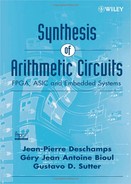9.5 HARDWARE DESCRIPTION LANGUAGES (HDLs)
A hardware description language (HDL) is a computer language designed for formal description of electronic circuits. It can describe a circuit operation, its structure, and the input stimuli to verify the operation (using simulation). A HDL model is a text-based description of the temporal behavior and/or the structure of an electronic system. In contrast to a software programming language, the HDL syntax and semantics include explicit notations for expressing time and concurrencies, which are the primary attributes of hardware. Languages, whose only characteristics are to express circuit connectivity within a hierarchy of blocks, are properly classified as netlist languages. One of the most popular netlist formats and industry standards is EDIF, acronym for Electronic Data Interchange Format ([EIA2004]).
Traditional programming languages such as C/C++ (augmented with special constructions or class libraries) are sometimes used for describing electronic circuits. They do not include any capability for expressing time explicitly and, consequently, are not proper hardware description languages. Nevertheless, several products based on C/C++ have recently appeared: Handel-C ([CEL2004]), System-c ([SYS2004]), and other Java-like based such as JHDL ([JHD2004]) or Forge ([XIL2004d]).
Using a proper subset of nearly any hardware description or software programming language, software programs called synthesizers can infer hardware logic operations from the language statements and produce an equivalent netlist of generic hardware primitives to implement the specified behavior.
9.5.1 Today's and Tomorrow's HDLs
The two main players in this field are VHDL and Verilog. VHDL stands for VHSIC (very high speed integrated circuits) hardware description language. In the 1980s the U.S. Department of Defense and the IEEE sponsored the development of this hardware description language with the goal to develop very high-speed integrated circuits. It has now become one of the industry's standard languages used to describe digital systems. Around the same time another language, later called Verilog, with similarity to the C-language syntax, was developed. In 1989, Cadence Company acquired the license, and later, in 1990, opened Verilog to the public. Both VHDL and Verilog are powerful languages that allow describing and simulating complex digital systems. Verilog is popular within Silicon Valley companies; while VHDL is used more by governments, in Europe, in Japan, and in most of the universities worldwide. Most major CAD frameworks now support both languages.
Another recognized HDL is ABEL (advanced Boolean equation language); it has been specifically designed for programmable logic devices. ABEL is less powerful than the formerly mentioned languages and is less used in the industry. Growth in complexity and strict time-to-market requirements for new system designs demand faster and simpler ways to describe system behaviors. The C++ and Java extensions, to support hardware description, seem to have a future because of the possibility to describe both hardware and software. The biggest challenge in this field is to have powerful synthesizers that can recognize and extract hardware and software from a previous nonhardware-oriented code. Most examples in this book are presented in VHDL.
